Welcome to FISH FOOD TIMES
Aug. 2015 issue No.140

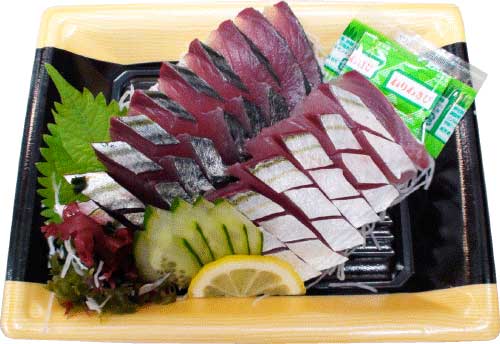
Indian mackerel hiratsukuri sashimi
Fellow of mackerel that is expanding more and more habitats
I think fish that Indian Mackerel that's mostly unfamiliar fish in the north of the region of Japan. Has been widely distributed in the tropical region of the Indian Pacific Ocean from the Nansei Islands of Japan, gurukuma of Japanese name is derived from Okinawan dialect is pronounced by extending the ending as "gurukumaa".
Indian Mackerel is a mackerel of fellow, adult fish, but will total length 40cm, when this fish compared to the Mackerel, small in body height is high, shorter thick.
�@�@�@�@�@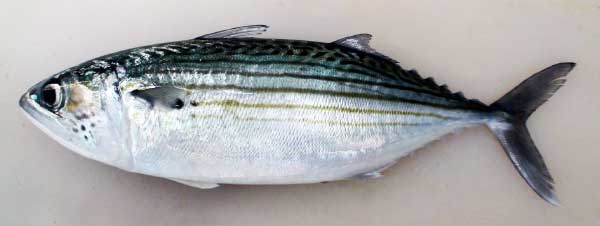
Indian Mackerel (English name: Indian mackerel, scientific name Rastrelliger kanagurta) is, Perciformes, Scombroidei, Scombridae, belongs to Rastrelliger, seems to swim the surface layer of the coastal zone in the horde. Food habits in the carnivorous, zooplankton, prey such as small fish. In order to eat feeding filtered plankton, part called gill raker in the gills (filtration organ of gills to separate the ones that sucked from the mouth to the foreign matter and water, such as food and pebbles) is well developed.
As a result of looking for the Indian Mackerel image on the net, in a blog called "Maldives here only of the story and how even good story of Eiko", it is believed to have been taken during the dive, open a big mouth in the sea, and eat strained through the plankton image of is that Indian Mackerel was listed.
�@�@�@�@�@�@�@�@�@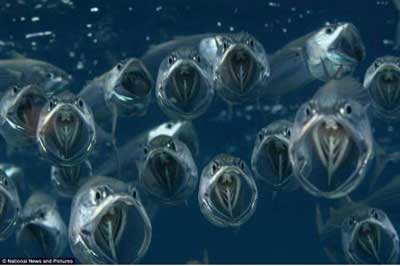
�@�@�@�@�@�@�@�@�@The more scary the Indian Mackerel powerful predation scene
If you look at this, gills of Indian Mackerel is well developed large, it can be understood that an important organ in the life support of the Indian Mackerel.
Indian Mackerel is, Melanesia from the Nansei Islands of Japan, Australia north coast, until the east coast of Africa, has been widely distributed in the Indian Ocean and tropical waters of the western Pacific, Indian Mackerel also has a kind of momentum, the distribution also in the eastern part of the Mediterranean in recent years the thing is of that spread.
In Southeast Asia, such as the Philippines, Malaysia and Thailand, Indian Mackerel is an important food fish, they are likely to be caught because the migratory widely made the flock, by methods such as fixed net, gill net, purse seine, a lot is fishing at a time that.
Since the Indian Mackerel is found even videos taken a state in which the swim in the flock, I want to watch the following YouTube if you are interested.
Video Indian Mackerel has taken a state in which swim�@mitsunori taniguchi�@
The image below is a good freshness that has been caught in the Amami Oshima Indian Mackerel (referred to as Ajaa in local). Indian Mackerel to price basis very cheap, have been trading always below 300 yen / kg, positioned in the category of under fish as a treat, in the Nansei Islands, such as the Amami and Okinawa are many fishing in the summer, it is mainly fried or it has eaten with sashimi.
�@�@�@�@�@�@�@�@�@�@�@�@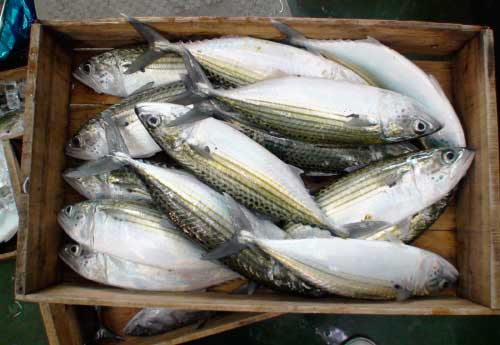
Indian Mackerel, which has been placed in wooden Toro box, was nearly 700g position from 600g weight per fish they contain 15 fish.
By the way, although the "Toro Box" is generally of a container of fish commonly known, why would you know whether the reason is called the Toro box.
The Toro box of Toro, it is meant that a container of fish that was harvested in the trawl fishery, which is a kind of bottom trawling. In order to pack a lot of fish at the time of landing in the market in the box, because the wooden special box has been used, it seems all of a container of fish became known as the Toro box.
Toro box will be three types of Styrofoam boxes, thin box · hon box as roughly. Styrofoam box has as those of various kinds countless, is now this is the mainstream of the Toro box.
Wooden Toro box is a thin box and bookcase, thin box with outer dimensions at 37.5 × 60.0 × 9.0�p, hon box external dimensions 37.5 × 60.0 × 13.0�p (only depth inside dimension) is.
Since the hon box is its depth is 4sun3bu (about 13�p), also referred to as forty-three boxes (yonsanbako), those of the bottom sawn network fishing forty-three box is standard. Blue fish that has been caught in the purse seine fishery (such as horse mackerel and mackerel), the box of thirty-eight boxes (sanpachibako) and called to have depth 3sun8bu (about 12�p) is the standard.
Yonsan box and sanpachi box, not only the depth of the internal dimensions, width even though different thickness one sheet of plate, sanpachi box is a plate one sheet of narrow 36.5 × 60.0 × 12.0�p.
The image below is a early morning landscape in the fish market in the northern Kyushu that is taken before many years. Truth horse mackerel is placed in sanpachi box, so that in a box that is overlaid on top not crushed a box of Truth horse mackerel below, had been stacked and also superimposed on what stage sandwich the horizontal bar between the upper and lower box.
�@�@�@�@�@�@�@�@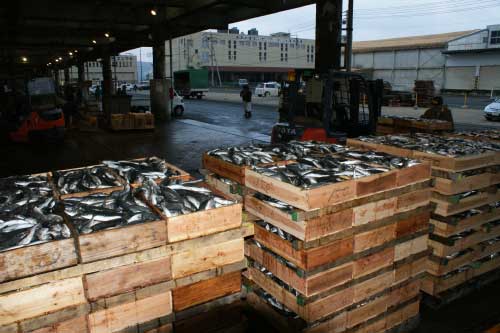
Because of these boxes does not contain still tag is the previous state of the auction, these fish now will be dropped auction to middlemen.If I think of things of old self, time of more than 30 years ago I was still young, in the Nagahama fish market in Fukuoka, rather than something bits and pieces amounts, such as the image of the above horse mackerel and mackerel, really fish of the dozens of times the very amount had been a landed at once.
At that time, the person that the auction of the consignment company, just riding dexterity on top of the wooden frame of sanpahi boxes piled up as mountains, overlooking the middleman feel like king of the hill, by raising the loud that it had been competing for these fish, I remember fondly.
�@�@�@�@�@�@�@�@
The above image is a landscape that Spratelloides gracilis has been landed in a fishing port in western Japan. Also have fish are placed in sanpachi box here, I would be in that box and you have a weight of fish from 15kg about 18kg, the weight by fish of the type and size seemed are very different , it seems to have entered enough firmly 18kg in the case of a density Spratelloides gracilis.
�@�@�@�@�@�@�@�@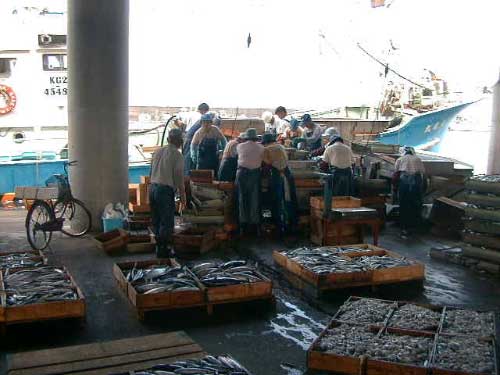
Also, looking at the image on top of another, sorting work and blue fish catch, such as mackerel, which is in large amounts catch at a time by purse seine vessels, so that the good is the most efficient work using the conventional sanpachi box as shown in the image , and the in the field of fish market with still a lot of manpower, has been a big success the old-fashioned sanpachi box.
And it is subjected to auction that contains fish in these sanpachi box, and since it dropped the bid such as brokers, in order to transport to Tokyo and Osaka of large consumption areas, there is a work called "re-built" from there, it will be shipped and then for the first time are subdivided in units of about 5kg~10kg in styrofoam box.
Most catch a large amount of fish in Japan is the mackerels, the average the past 10 years up to 2013 and accounted for 50 million tons, about 10% of the total catch of Japan. It is predicted increase landings because quota this year (TAC) has increased from 70 million tons to 90 million tons. Cause Mackerel resources is increasing, that there was the Great East Japan Earthquake in March 2011, mackerel that fled the catch of March to June is the spawning period of Mackerel is spawning in large quantities, mackerel is born at that time large quantities are spawning in 2013 spring, it is that the two-year-old fish of the 2013 born mackerel have been caught steadily this year, has been reported in the article of Minato newspaper.
However, according to the article, the center size of mackerel have been caught because it is 250g and small size from 200g, beach price 38 yen / kg about not only, it seems not only to the meal and aquaculture for frozen bait for.
Although such sufficiently child mackerel that is not growth is rapidly caught in Japan, it is impossible to catch the following mackerel 30cm outside food in Norway, since the fishermen also individual allocation scheme, they are not able to use the specially valuable quota that to obtain a small mackerel.
Norway is has been said that fishing developed countries than in Japan, author what is how advanced the do not know anything. Since were found YouTube videos that can know some of its advanced nature, let me introduce to you.
Mackerel fishery of Norway(1/3)�@photographer Toshio Katsukawa (Tokyo University of Marine Science and Technology industry, academia and regional cooperation promotion mechanism Associate Professor)
Looking at this video, no doubt that indeed it is very different from the port of landing landscape of Japan. However, the author of the that some, such as in the image "a lot of people alive with fish market landscape" in which has been described above and there is a feeling that does not want to deny.
Lively atmosphere of the early morning fish market, those kind unique that only human beings involved in the fish know, not only the fish landed in the fish market, what are There are a lot of people involved in it, increases its value I think it's as.
Mackerel landed in Norway, the thing with going to be transported to the refrigeration plant without being touched at all in the hands of the people by the power of the pump.
But This is like factory products, it is much to far I felt from the atmosphere of "fresh fish fishmonger's sell" in Japan.
In Japan, now is like a scene such as saury that is sucked up by the pump in the same way so that the not uncommon, mackerel also landscape of landings in domestic developed regions in the same way also sardines, such as the Norwegian way and it does not maybe have changed to, I not likely become a feeling to accept in favor of such a spectacle.
Now the story of Indian Mackerel of Toro boxed is, because imperceptibly happen to migration topic that Norwegian mackerel, I will try to be returned to talk to Indian Mackerel.
Indian Mackerel Though had also mentioned that the mackerel general from the fact that they belong to the mackerel family, this fish is in spite of multi-catch of fish species will not be getting to debut in stores as of mackerel. Maybe this is the reason very low market price, I'm guessing whether not because reluctant to fishing by fishermen is favored.
Indian Mackerel in terms of taste, there is no sure the taste is bad because it is fish red meat close to the tuna and bonito is a fellow of the mackerel family, in terms of "good balance of catch and taste and price", this fish is more I think I do not may be attention.
Near the Nansei Islands, in a sense has been treated with the feeling such as "What ... Indian Mackerel or ...", a decade ago sardines had been treated, either would not be a treatment of such fish below.
�@�@�@�@�@�@�@�@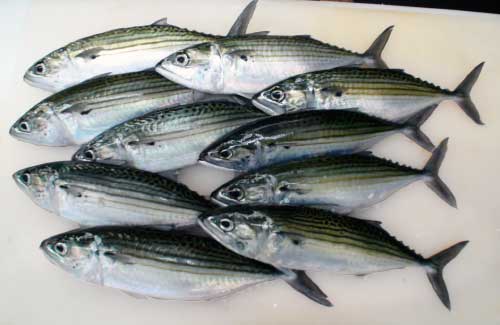
If the image above but Indian Mackerel which was placed on the cutting board, to cook it,
�@�@�@�@ �@
�@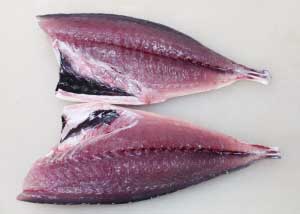
As in the image above, the color of the body and the body quality, neither mackerel, nor bonito, nor in the tuna, which in like not like, such as similar, are also like that.
Skin Indian Mackerel, using the same method as mackerel, conveniently and that tear pulling by hand rather than with a knife, taking the skin in this way, as in the image below, the pattern of similar skin and mackerel is directly it will be to come out to the surface.
�@�@�@�@�@�@�@�@�@�@�@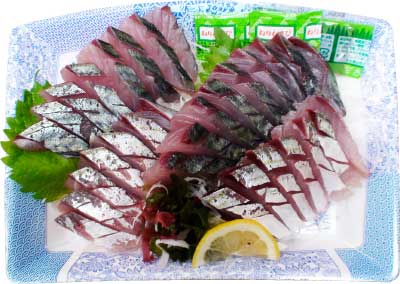
Sashimi hiratsukuri of Intro image has Serve a half-length content, but the image above is serve one fish worth. This only volume one fish worth of cost in of because he does not even to 150 yen, and he will be able to ensure the markup ratio of margin even put a considerable cheap selling price.
�@�@�@�@�@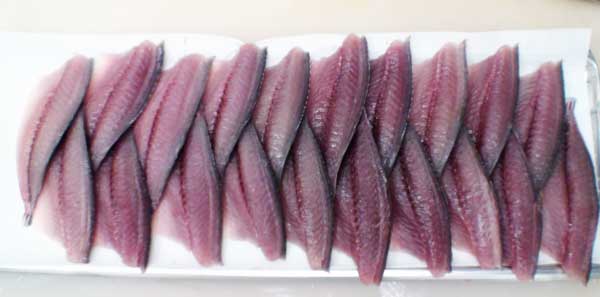
When I lined up to dismantle the 10 fish worth among you purchase one box to sanmaioroshi the Indian Mackerel, it would not look like a bonito.
From now on, commercialization, but you anything good in fillets in sashimi, anyway because purchasing costs he such below 100 yen in the half of the body, he can not have it is not profitable even if in any form.
This Indian Mackerel is not a rare fish such as unobtainable, is a multi-catch of fish species that have extended the force to the sea around the world and, if it is the mood, how to purchase should abound.
Readers are, at any time it is easy to get, without the purchase risk, such as trouble is not selling, everyone knows to normal, so are stable sticking to the relatively high price, is chasing the only such fish do not you?
The coastal waters of Japan, have a lot of fish that have not been fully utilized as a target to eat still, that this is what I want to think again to readers that.
An opinion and the communication are to iinfo@fish food times
Date of updating Aug.1, 2015
